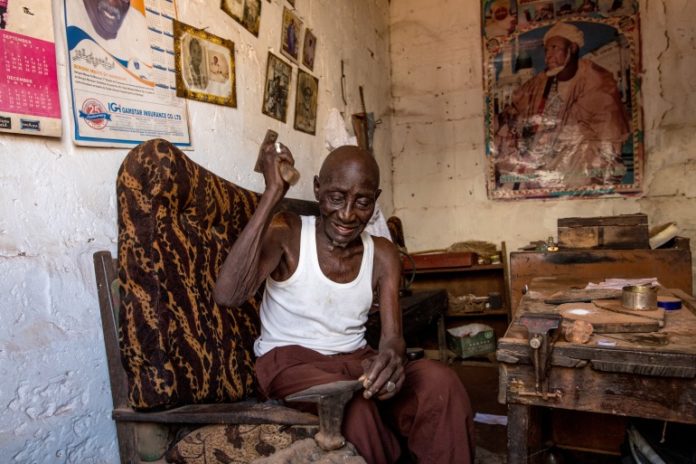Listen to this story:
Brikama, The Gambia – On an early November morning, 102-year-old Ebou Janha rests a pair of pliers next to his jeweller’s anvil and collects his breath before demonstrating how he gunned down Japanese soldiers for the British Empire, 77 years ago.
Speaking in the small white-walled workshop he built in the 1950s when The Gambia was still a British colony, Janha manages five or so Wolof words at a time while his daughter, 55-year-old Mamtutti, translates.
His memory flickers into action as he recalls how, in 1941 when he was 22 years old, he was captured by village elders and sent off to fight against an enemy he had never heard of before.
During World War II, the recruitment of Gambian soldiers was often enforced via a quota system with the 36 local chiefs pressured to supply Britain with 48 servicemen each every month – a number that increased to 75 in March 1943.
British officials also conducted round-ups of unemployed men in the capital, Bathurst (now Banjul), to enlist them into military service. While some soldiers chose to fight, such as the men from Balangar – a village steeped in martial tradition where 35 friends signed up to fight on the same day in 1941 – many others were forced to.
When British army recruiters called for volunteers to sign up, Ebou Janha had little interest in war or the martial culture of his ancestors.
He was born the son of a jeweller in Bathurst and had become his father’s silversmith apprentice. He also joined his family in yearly seasonal migrations “upcountry” to their ancestral village of Bwiam, where he harvested groundnuts to be sold in Bathurst with the profits ploughed back into the family’s jewellery business.
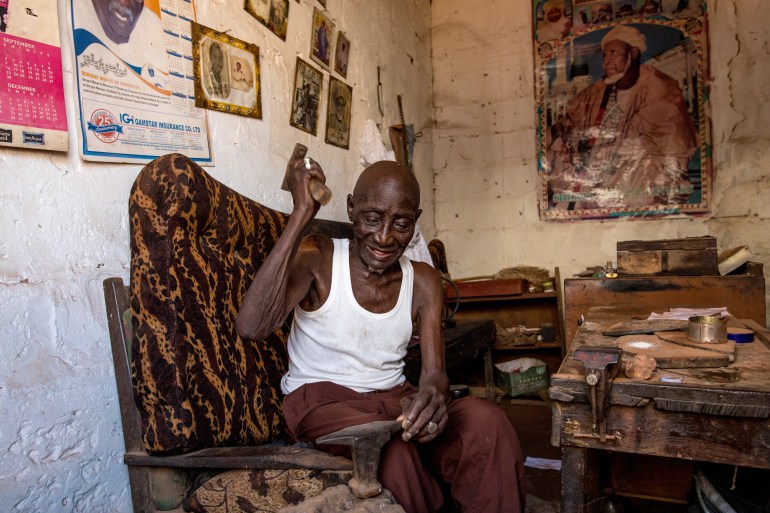 Janha works in his workshop in Brikama [Muhamadou Mughtarr Bittaye/Al Jazeera]
Janha works in his workshop in Brikama [Muhamadou Mughtarr Bittaye/Al Jazeera]But Janha’s wishes counted for little. During one of his seasonal migrations to Bwaim, he was chosen by his chief for his stocky frame and stubbornness; destined to become one of the few from the village to fight. With ropes tied around him to prevent his escape, he was given days to compose himself and accept his fate.
The young jeweller became one of 4,450 recruits split between two regiments: 2 Gambia Regiment, which stayed in The Gambia to defend home soil; and 1 Gambia Regiment – 1,350 men including Janha who were given training in jungle warfare, before the Royal Navy put them on boats to war in Burma, (modern-day Myanmar), which had been part of British India, in January 1944.
Founded in 1901, The Gambia regiment existed until 1958. Its men fought in both world wars, but Janha is the last surviving member of the regiment to have fought in Burma.
Each day hundreds of people walk or drive past his shop in the sprawling town of Brikama, cars beeping their horns and kicking up the dry-season sand just a foot from the door, unaware that a World War II veteran works inside, carving out silver-coated earrings, bracelets and rings.
Preparation and protection
In 1942, after Janha and the rest of the recruits had finished their basic training, they were given eight weeks to “prepare their bodies”, an ancient code meaning to gather their possessions, prepare their wills and begin a “juju” pact with the spirits. Followers of the ancient West African belief system sacrifice a goat or a calf and offer a shilling to the marabou or medium in exchange for protection or blessings. During World War II, Gambian soldiers often carried elaborate juju amulets on their belts.
Following jungle training in The Gambia and Nigeria, the 81 West Africa Division’s 6 Brigade – which included Janha’s battalion from the 1 Gambia Regiment as well as battalions from Nigeria and Sierra Leone – set sail from Nigeria on July 10. They arrived in Bombay, now known as Mumbai, India on August 14, 1943.
 Troops leaving Nigeria to travel to Burma in 1943 [Courtesy of the Gambian National Archives]
Troops leaving Nigeria to travel to Burma in 1943 [Courtesy of the Gambian National Archives]Six months of training followed, before 6 Brigade travelled to Burma, making an amphibious landing as Royal Navy guns blasted Japanese positions in the distance.
“The firing started on the ship. Heavy fire! It continued until we landed and everybody rushed into the bush,” Janha explains, becoming animated as he remembers his first taste of war. The sleeves of his delicate white tunic flutter as he mimics the Royal Navy’s big guns launching their shells.
“Private Amadou, Private Banta and Sergeant Njie,” he says, reeling off the names of his closest friends. “The three of us together.”
They formed part of a force historians would later call ‘The Forgotten Army’ on account of how their operations in the Burma Campaign were overlooked by Fleet Street and the rest of the contemporary press.
The Forgotten Army
Officially called the United Kingdom’s Fourteenth Army, the Forgotten Army was formed in 1943 to fight the Japanese in Burma. It was made up of 13 infantry divisions with nearly a million men by late 1944, drawn from two West African Divisions, one East African Division, eight Indian Divisions and two British ones.
The two West African Divisions included emigre Polish officers who had escaped to Britain when Nazi Germany occupied Poland. As many of the Poles could not speak English, they communicated with the West African soldiers in pidgin English, which had been used as a trade language in West Africa for more than 200 years.
 The 1 Gambia Regiment company after returning from Burma in 1946 [Courtesy of the Gambian National Archives]
The 1 Gambia Regiment company after returning from Burma in 1946 [Courtesy of the Gambian National Archives]After a hurried beach landing and with his bayonet fixed, Janha was soon hacking his way through the dense undergrowth, heading for the steep, verdant summits where he and his comrades would engage Japan’s formidable 55th Division. It was this Division that had smashed China’s own 55th Division as it conquered Burma and drove British troops out in 1942.
The terrain in the isolated Arakan region of western Burma was inaccessible and harsh, but for the next two years, it would become home to more than a thousand Gambian soldiers.
In the early days of the campaign, the enemy looked like little birds at the top of those tall hills, says Janha, describing how the Japanese and African soldiers jabbed and slipped like two prizefighters trying to get a feel for each other’s power in the opening rounds; both aware they were in for a long fight.
Just three days after landing on January 22, the West African troops had to cross the Kaladan River – which traverses mountain passes before snaking down to the rice paddies below – to get at the Japanese, who were well dug in inland and out of range of heavy artillery.
But soon after crossing the river, three members of the 1 Gambia Regiment were killed in an ambush. Janha found himself stealthily crawling along the ground, cutting his way through shrub and thicket, making sure his amulets stayed tied to his belt.
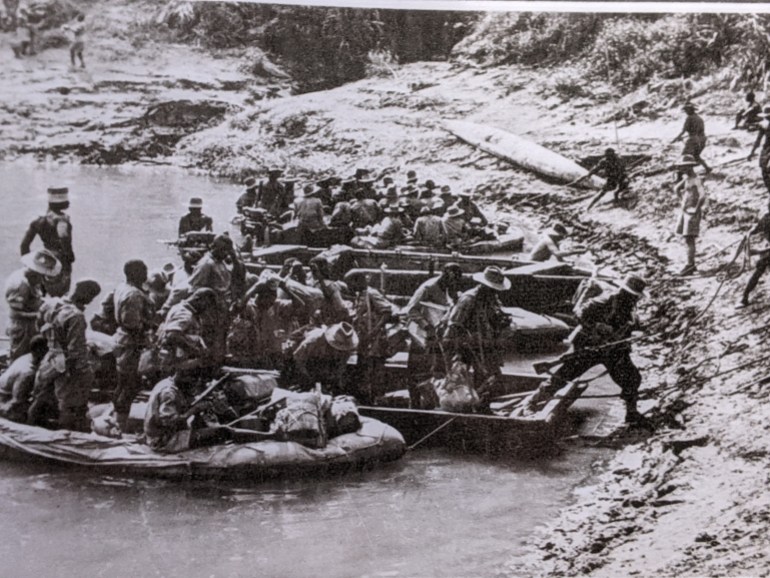 Gambian soldiers cross the Kaladan River in January 1944 [Courtesy of Kachikally Museum]
Gambian soldiers cross the Kaladan River in January 1944 [Courtesy of Kachikally Museum]“You will meet the Japanese standing and you would not know whether this person was a human or not, because of the masks they used, and the traps they made, but they used to say of us when we captured them, ‘Gambians, small but hot,’ because we used jujus and they couldn’t take many of us,” Janha recalled as a regular customer entered his shop, looking to get a signet ring adjusted and joking about how the “old man” still refused to use a smartphone.
Enemies on all sides
Janha fought for two years in the jungles and on the hilltops of Burma.
There were exceptional acts of bravery and stoic acts of resistance as 6 Brigade defended strategically important locations against often relentless enemy fire. But that did not stop many of its members wondering how they had got there, then later, when they returned home, questioning why their exploits had been ignored.
When German leader Adolf Hitler went on a blitzkrieg to Paris in 1940, causing the French to surrender and the establishment of the puppet Vichy regime, the British colony of The Gambia had found itself surrounded by enemies on all sides. French West Africa – a federation of eight French colonial territories which are now Mauritania, Senegal, Mali, Guinea, Ivory Coast, Burkina Faso, Benin and Niger – was suddenly at war with the UK and its colonies.
The tiny sliver of land on the lush banks of the River Gambia had served Britain’s interests during the transatlantic slave trade. And afterwards, when Britain colonised the country, many years of bountiful groundnut harvests had yielded profits that were siphoned off into governing the UK’s priorities along the coast in Sierra Leone.
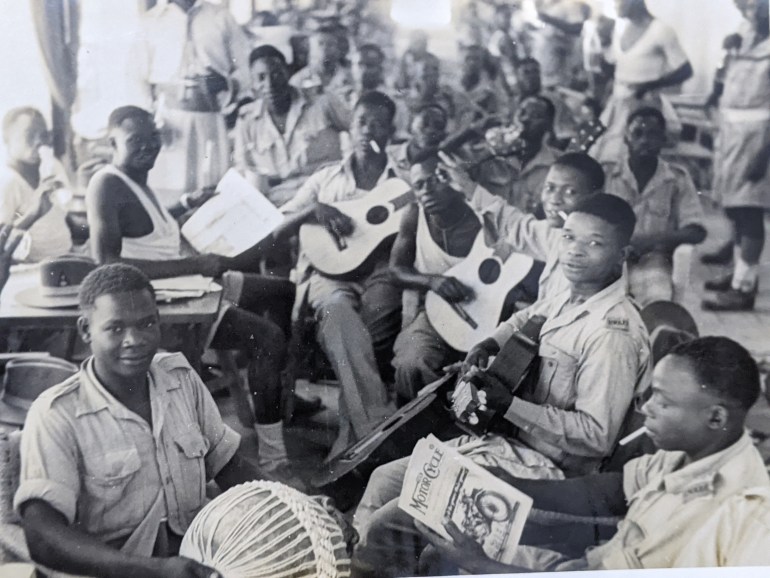 A mix of West African troops on leave in 1945 after the war, waiting to travel home [Courtesy of the Gambian National Archives]
A mix of West African troops on leave in 1945 after the war, waiting to travel home [Courtesy of the Gambian National Archives]Yet The Gambia remained a colony Britain did not know what to do with and had little interest in developing. A succession of British governments had used the territory as a bargaining chip, hoping the French would trade Guinea – or another of its colonies in the region – for their smallest colony in Africa.
But now, with Britain at war, The Gambia was an important asset in danger of invasion. When the British took the fight to the pro-German Vichy French administration at The Battle of Dakar in September 1940, two British battleships and two cruisers were damaged.
The loss made Britain increasingly aware that Bathurst was of naval importance and so the Royal Air Force built three bases in 1941 from which their Hurricane fighter planes could dominate the region’s skies.
But as these defences were being built, Britain’s army was licking its wounds thousands of miles away as Japan captured Hong Kong, Malaya (now called Malaysia), Singapore, and Burma. Soldiers from the British colonies in Africa would now be needed to help stem that tide, and block Japan’s advance into India.
‘Thank God I’m alive’
The first months of fighting went badly for the Gambians. The jungle was thicker than anything the men had experienced before and dozens were struck down by snake bites, booby traps and malaria.
“Our men weren’t very well prepared for the jungle involved,” says historian Hassoum Ceesay, surrounded by books in his study at the Gambia National Museum, where he is the curator.
“Remember these are mostly village chaps or men from the savannah. Yet perhaps the British thought, well, ‘these are Africans and they are used to the bush,’ calculating they were used to being in jungles, being around snakes, spiders and eating wild fruit. ‘So let’s send them into the jungle’. It’s not surprising that initially, these Gambian soldiers had this ecological fright, and needed a moral regrouping.”
 Members of 1 Gambia Regiment in Burma in 1944/45 [Courtesy of the Gambian National Archives]
Members of 1 Gambia Regiment in Burma in 1944/45 [Courtesy of the Gambian National Archives]The majority of the 127 Gambian soldiers who died in Burma were killed during the torrid months of February to April 1944; a chapter defined by merciless treks deep into the jungle as blood-sucking leeches attached themselves to their exposed skin and concealed enemy fighters lay waiting to ambush them.
On February 12, Janha’s D company suffered nine losses with almost 30 wounded as they besieged Kaladan village. The Japanese were waiting for them with a machine gun the Gambians nicknamed “Kaladan Sam”. Its rounds tore through flesh at ease, creating exit wounds the size of mangos. The regiment was forced to retreat.
One week later they crouched on the flank of the 4th Nigerian regiment as they charged up Pagoda Hill – a landmark that gave its occupier the advantage of a prime view over the Kaladan River. The Nigerians destroyed the Japanese position.
Then, on March 1, 1 Gambia Regiment was given orders to defend Pagoda Hill “at all costs”, but when the Japanese initiated their counterattack the Gambians were outflanked, overrun and forced to retreat north with the rest of the 81st West Africa Division. They were pursued by the Japanese for more than a week.
The capitulation on Pagoda Hill was Private Janha’s and the regiment’s nadir in Burma. Twelve Gambians were killed, another 30 were wounded, and 21 went missing, “presumed captured, mutilated and executed by the Japanese,” says Ceesay, as he reads from an archive.
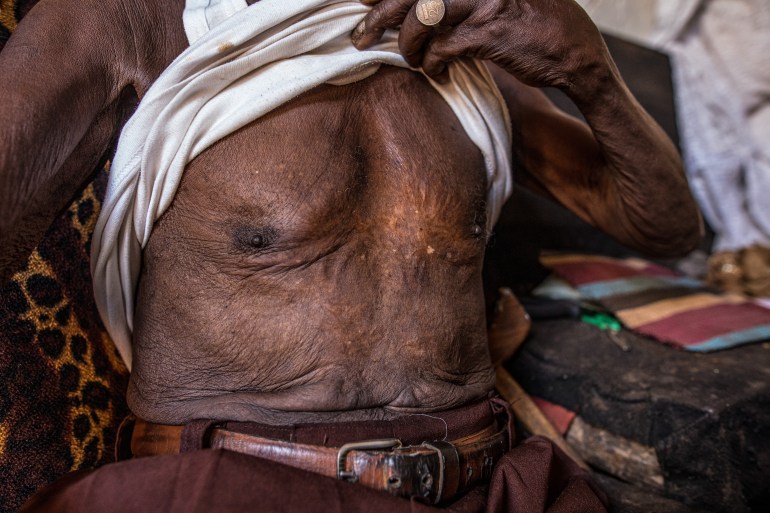 Ebou Janha shows the scars he suffered from a grenade explosion in Burma in 1944 [Muhamadou Mughtarr Bittaye/Al Jazeera]
Ebou Janha shows the scars he suffered from a grenade explosion in Burma in 1944 [Muhamadou Mughtarr Bittaye/Al Jazeera]When Al Jazeera asked Private Ebou Janha about the retreat from the hill, he lifted his shirt to reveal clusters of scar tissue running from his chest to his waist. With four other members of his unit, he had fallen into a deep booby trap the Japanese had set, hoping to impale the Gambian soldiers as they fled. Before they could escape it, a Japanese soldier threw a grenade in.
“The grenade was powerful! It made me like this. My eardrums were burst. But thank God I’m alive,” Janha says, recalling how he managed to control the urge to scream in pain as he burned and then to climb out of the trap as his four friends lay dead inside it.
More than 10 men from D Company 1 Gambia Regiment were left behind Japanese lines on Pagoda Hill. It took three weeks for most to find their way back to the battalion.
Acts of heroism
The Gambian soldiers were continually forced to retreat and a nasty cholera outbreak ripped right through them, causing many to believe they had been cursed. Historian Ceesay says it was “a certainty that all men in the regiment practiced juju” and those still alive would have likely attributed the deaths of their comrades to a lack of juju discipline – breaking their side of the deal they had entered into with the spirit realm.
They believed the spells could be broken by blunders such as not taking their amulets off when they prayed, went to bed, or relieved themselves, or by getting them dirty in the mud of the jungle – or some other failure to fulfil the promises they had made to the spirits before setting sail.
The officers of 1 Gambia Regiment decided it was time for drastic action. They reorganised the men to ease their concerns, dividing the Gambian soldiers between various platoons. They were taken out of action, joining the Indian units of 7 Battalion of the 16th Punjab Regiment for a few days away from the front.
 Janha and family outside his house [Muhamadou Mughtarr Bittaye/Al Jazeera]
Janha and family outside his house [Muhamadou Mughtarr Bittaye/Al Jazeera]“Many of these men were Bambara (a Mandé ethnic group throughout much of West Africa) and they had this primordial attachment to not being humiliated, to not being defeated in the battlefield,” says Ceesay. “So, you have that and you have the juju power they practiced, and then you have a very potent recipe to go back and fight and restore their honour.”
Rested and reorganised, the Gambian soldiers were soon back on the march again, and their chance for atonement quickly arrived.
Between May 14 and 20, 1944, the entire 1 Gambia Regiment had to defend Frontier Hill, an elevation guarding Mowdok, and the Mowdok-Baungprei track leading into India.
For one week the Gambians fought off “three major and six minor Japanese attacks”, refusing to budge an inch. These victories spurred the Gambians on, just before the monsoon months came, and with it the rain and mud that forced both sides to stop the relentless attacks, and give their men some rest.
Some months passed and the rains stopped, and when they did, one of the greatest acts of heroism in modern Gambian history took place.
 Janha wearing his medal on the porch of his home in Brikama [Muhamadou Mughtarr Bittaye/Al Jazeera]
Janha wearing his medal on the porch of his home in Brikama [Muhamadou Mughtarr Bittaye/Al Jazeera]One-man attacks
Sitting down with his older brother in Serekunda, the largest city in The Gambia, Momodou Kindi Camara waits as his son and niece return from work and enter the family compound. The muezzin fills the air with the early evening call to prayer.
One by one the family members perform their ritual Islamic washing as Momodou Camara explains how on December 19, 1944, his father Kindi Camara marched with the regiment as they moved out through villages and rice fields under the noonday sun.
As they passed through a farm, the men suddenly launched themselves to the floor. Bullets whizzed by and mortar fire exploded all around them. As Kindi Camara’s medal citation reads:
“Without hesitation, firing his Bren Gun from the hip, Pte *Kamara charged the enemy position across 200 yards of open paddy. The enemy concentrated LMG [light machine gun], rifle, and grenade discharger fire on him, but totally disregarding personal safety, he continued his charge. In face of this deadly persistence, the enemy abandoned his positions and fled in confusion.”
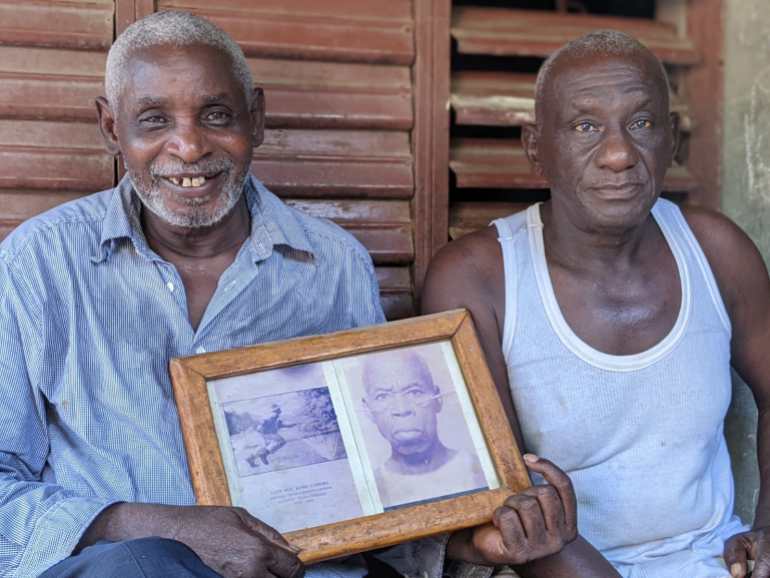 Momodou Kindi Camara holding a photo reenacting his fathers charge against Japanese lines [Will McBain/Al Jazeera]
Momodou Kindi Camara holding a photo reenacting his fathers charge against Japanese lines [Will McBain/Al Jazeera]This was not the first or last instance of a single Gambian soldier forcing an entire Japanese unit to retreat, before the aircraft Enola Gay’s bomb bay doors were opened on August 6, 1945 to drop “little boy” on the Japanese city of Hiroshima, changing the world forever. Three days later the United States dropped a second nuclear bomb on Nagasaki. Emperor Hirohito ordered the Japanese army to lay down its weapons.
For the Gambian soldiers, the war was over, but they had to wait until December 1945 for the troopship SS Empire Pride to sail them home. They reached Bathurst in January 1946. The day after they arrived the Gambia Echo newspaper reported the deputy British governor saying all the returning troops did “was talk, talk, talk”.
But these trained soldiers could not only now fight, they had also learned mechanics and engineering and discovered new agricultural methods during their time in Burma and India, and as the renowned Senegalese film director and former colonial soldier, Ousmane Sembène, put it: “In war, we saw the white men naked and we have not forgotten that picture.”
It would take some time but the death knell of colonialism had been rung. In 1965 The Gambia won its independence. Many of Gambia’s Burma veterans joined the pre- and post-independence security and police forces. Others like Ebou Janha and Kindi Camara spent their post-war lives trying to work their way out of grinding poverty.
“What I get from this shop is what we eat,” says Janha, with a mischievous smile as Mamtutti hands him his packed lunch of “domada” – a peanut stew – and encourages him to eat.
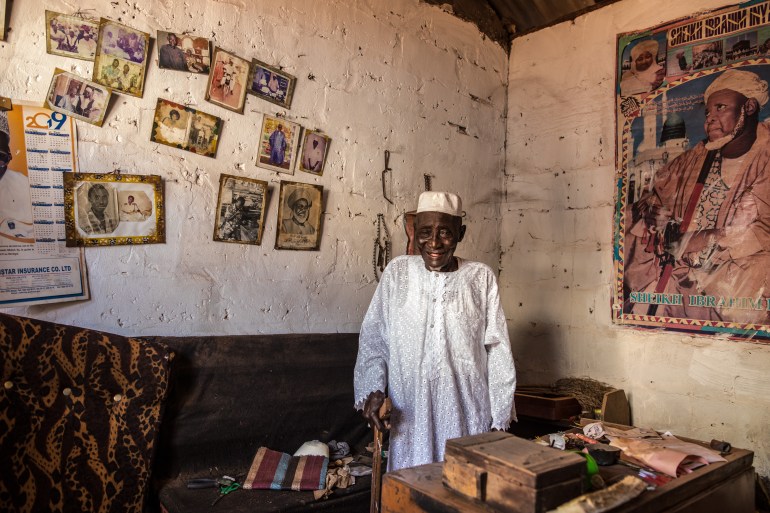 Old photos of Ebou Janha are displayed on the walls of his workshop [Muhamadou Mughtarr Bittaye/Al Jazeera]
Old photos of Ebou Janha are displayed on the walls of his workshop [Muhamadou Mughtarr Bittaye/Al Jazeera]Momodou Camara and his family hold Kindi’s legacy close but are bitter at the way the British washed their hands of him and his descendants, after running the country into the ground.
When American President Franklin D Roosevelt visited The Gambia in 1943, he was so appalled at the homelessness and disease he witnessed that when speaking to UK Prime Minister Winston Churchill, he referred to it as “that hell hole of yours”. What he saw in Bathurst further consolidated his anti-colonial views according to his son, Elliot, a lieutenant colonel in the US Army Air Corps.
One son of a Gambian Burma veteran said that all the British left “was a prison, a hospital, and an asylum.”
For decades following the war, the British and the Gambian Legion’s, and the Royal Commonwealth Ex-Services League (RCEL) – an organisation founded in 1921 to represent the interests of Commonwealth citizens who have served with either the British or Commonwealth Forces – have provided grants, medical funds, and scholarships to veterans and their children, but not all received help.
Many Bambara men picked up the semi-nomadic life they had left in 1943, and others filtered back into their rural villages, hoping to forget the bloodshed.
Alpha Jallow, whose father crossed a river behind enemy lines in Burma to save a badly wounded Rhodesian (now Zimbabwe) officer, and swim with him back to safety, helped set up the World War II Veterans Family Association. For years they have been scouring the country supporting widows and attending the funerals of the last remaining soldiers. Jallow hopes “learning about Gambia’s war heroes will become part of the national curriculum.”
On Remembrance Sunday, as people in the UK and elsewhere remember the sacrifices of some of those who died, Ebou Janha will likely be in his workshop.
“Even if I’m sick I like to come to my workshop,” he says. “I thank God I’m alive now. And I’ve thrown away all my juju,” he adds as he tucks into his stew.

